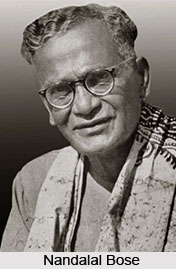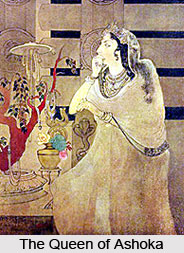 The Indian art of painting had almost died down in the nineteenth century. Even the Indians accepted their inferiority in this respect. Late E. B. Havell, the Head of the Calcutta School of Art, together with his colleague and fellow-artist, Abanindranath Tagore began to preach the beauty of Indian art. World began to recognise the significance and richness of Indian art. Tagore was regarded as a creative artist who revealed the soul of India to the world. In France, Paris organised an exhibition of the `Tagore School of Painting` that stole the heart of every French lover.
The Indian art of painting had almost died down in the nineteenth century. Even the Indians accepted their inferiority in this respect. Late E. B. Havell, the Head of the Calcutta School of Art, together with his colleague and fellow-artist, Abanindranath Tagore began to preach the beauty of Indian art. World began to recognise the significance and richness of Indian art. Tagore was regarded as a creative artist who revealed the soul of India to the world. In France, Paris organised an exhibition of the `Tagore School of Painting` that stole the heart of every French lover.
Soon there were exhibitions in other places like London, New York, Japan, China, Korea, Java and Australia. A society called `The Indian Society of Oriental Art` was established and classes were taken by Tagore. There was also an issue of a new journal of art called `Rupam` under the editorship of an art-critic O. C. Ganguly. N. C. Mehta, Raval, Stella Kramrisch, Karl Khandal ivala and G. Venkatachalam worked for Indian art.
Abanindranath Tagore is known as the father of the new renaissance in painting. He came across Indian paintings and he felt a call to go after the old Indian artistic styles. He took lessons from an expert Indian craftsman and painted Radha Krishna series. Later on he was inspired both by Havell and Tagore. Then he joined the Indian Society of Oriental Art and trained pupils who are famous today, namely Aurendra Ganguly, Nandalal Bose, K. Venkatappa, Hakim Khan, Asit Kumar Haldar and Samrendranath Gupta.
They were taught the old Indian technique by Ishwari Prasad Varma, a hereditary painter after the old Rajput style. All of them have become international figures. Abanindranath`s work was a turning point in Indian artistic history. He raised India from the depths of humiliation and has regained for India the honoured position.
In Abanindranath`s works one finds a perfect blending of Hindu motifs, Persian colouring and methods of Japanese painting. Freshness and vigour, individuality and synthesis are the features of his art. His masterpieces are `the Passing of Shah Jahan,` `The queen of Ashoka,` `Aurangzeb,` `Radha Krishna` and `Buddha the Mendicant.` He remains an individual genius with a flair for synthesis. Creative spirituality was visible in his collections. Gaganendra Nath Tagore, the elder brother of Abanindranath was one of the best artists in India.
 Paintings, caricatures, cartoons, landscapes and impressionistic or cubistic pictures came profusely and almost without an effort from his versatile hand. Some of his masterpieces are `Rainy Landscape in the Himalayas,` `My Inner Garden,` `Flame of the Forest` and `The First Gleam of Light.` K. Venkatappa of Madras was another artistic genius of India. Asceticism was clearly visible in his paintings. He was also a versatile genius and has painted portraits decorated with reliefs on the walls of Mysore palace, the Amba Vilas, and created other works of art like the landscape studies` of Ooty,` `Bird study` and `Ram and the Golden Deer.`
Paintings, caricatures, cartoons, landscapes and impressionistic or cubistic pictures came profusely and almost without an effort from his versatile hand. Some of his masterpieces are `Rainy Landscape in the Himalayas,` `My Inner Garden,` `Flame of the Forest` and `The First Gleam of Light.` K. Venkatappa of Madras was another artistic genius of India. Asceticism was clearly visible in his paintings. He was also a versatile genius and has painted portraits decorated with reliefs on the walls of Mysore palace, the Amba Vilas, and created other works of art like the landscape studies` of Ooty,` `Bird study` and `Ram and the Golden Deer.`
Nandlal Bose enjoys popularity throughout the world. He is true to the ancient art of India and the pathway at Haripura and Faizpur show how ancient India must have lived. He has brought out the import of Indian legends and religious stories. Some of his famous creations are `Shiva mourning over Parvati,` `Sati,` `Uma`s grief,` `Garuda,` and `Kaikeyi.` His forte is the vigorous expression of his lines. He has recreated the masterpieces of Ajanta.
Among other artists of fame are Devi Prasad Choudhry, M. A. Rahman Chaghatai, Sarda Charan Ukil, Mukul Chandra Dey, Rabindranath Tagore and Amrita Sher Gil. Recent trends are towards independence and adoption of the Western art. Of such artists the best known are M. F. Hussain, Mali, V. D. Chinchalkar, Abani Sen and Kamala Das Gupta. They follow the latest styles of Europe-post-impressionism to wit.
There are a number of art-centres or societies in India like Andhra Kalashala, Muslipattam, Baroda Kala Bhavan, Art Schools in Kolkata, Patna, Lucknow, Mumbai and Madras, Kala Bhavan, Shantiniketan and the All-India Fine Arts and Crafts Society of New Delhi. There are art journals among which Marg is the most famous. India has registered a great progress in the art of painting. However of late the art shows signs of flagging and inspiration have disappeared. Originality has given place to caricature and aping the Western art. Art-revival is possible when originality is combined with respect for tradition. Rhythm, balance and harmony are the essentials of art.
 Art in India was communal, deeply religious and followed traditions laid down in the Shilpasastras. Hindu religion conceived of the universe as the creation of the desire kindled in the one to manifest him in the many. Supreme Being created the Universe, and he breathed his spirit into it. Hindu art is based upon this philosophy. The artist must find the unity of one God and this is possible only when he is endowed with form because human beings are limited and finite and can meditate best before form. Symbolism was developed to express the multiplicity of God. The idea of a Yogi inspired Indian art and further God was portrayed in superhuman forms as he was not the image of man. Thus the Indian art is subjective while the Western is objective or materialistic. Indian art differs from Western art in its ideals as well as in its expression and technique. Western art is essentially realistic and representational, secular and scientific, while Indian art is suggestive and symbolic, religious and idealistic, where intuition and imagination play a greater part than the mere skill of hands and command over technique. These differences are the results of historical circumstances and when there is a more frequent communication between the peoples of the world they are bound to lose their sharpness or some common types may be evolved.
Art in India was communal, deeply religious and followed traditions laid down in the Shilpasastras. Hindu religion conceived of the universe as the creation of the desire kindled in the one to manifest him in the many. Supreme Being created the Universe, and he breathed his spirit into it. Hindu art is based upon this philosophy. The artist must find the unity of one God and this is possible only when he is endowed with form because human beings are limited and finite and can meditate best before form. Symbolism was developed to express the multiplicity of God. The idea of a Yogi inspired Indian art and further God was portrayed in superhuman forms as he was not the image of man. Thus the Indian art is subjective while the Western is objective or materialistic. Indian art differs from Western art in its ideals as well as in its expression and technique. Western art is essentially realistic and representational, secular and scientific, while Indian art is suggestive and symbolic, religious and idealistic, where intuition and imagination play a greater part than the mere skill of hands and command over technique. These differences are the results of historical circumstances and when there is a more frequent communication between the peoples of the world they are bound to lose their sharpness or some common types may be evolved.



















